Invicta Flies - Wedge-Wing Style, page 2
5.) Once the hair bundle is propped up, apply a drop or two of Dave's Flexament to its base. Grasp and let go of the bundle a couple times to allow the cement to reach all fibers. Before it dries, use your thumbnail and the pad of your second finger to flatten and shape the wing. You may have to do this a couple times as is dries to gather all the fibers together. Pushing down slightly toward the hook shank will give you a sparser, wider wing. Stroking up toward the tips will give you a narrower, tightly formed wing. Allow a few minutes for the wing to dry then finish the pattern.
 Lt. Cahill with wider wing.
|
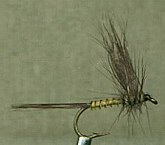 B.W.O. with narrow wing.
|
Hackle on Wedge-Wing Dries
To ensure proper balance for the single wing and allow the fly to rest closer to the water's surface, trim the hackle on wedge-wings on the bottom, creating an upside-down "v" shape.
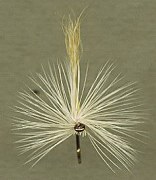
Double Wedge-Wings
To create two wings, simply double the amount of hair then use figure eight wraps to divide the bundle after propping up. Take a couple loose turns of thread around each bundle to gather the fibers a little. Use the Dave's Flexament and flatten the wings one at a time. On double wedge-wings, any hair stiffer than reindeer will tend to twist your leader when the fly is cast.
Trimmed Wedge-Wing

Remember the butt ends we put back into the stacker? Now we'll use them to make a trimmed wing. You can also make this wing from the beginning, but to me that is a waste of materials. The steps are the same, with a couple of slight differences. Even the tips in the stacker as before. This time, tie the bundle on top of the hook by the tips, the butt ends to the rear of the hook. Prop up, then clip the bundle so the ends are even and the hairs about one and a half to two inches long. This will help us control the bundle as we flatten it. Apply the Flexament as before and form a wide or narrow wing as desired. Try to keep the wing full (minimal space between fibers) as this will ease trimming. Once the wing is dry, and before finishing the fly, use sharp scissors to trim the wing to shape. This method creates some very realistic flies, suitable for the most finicky of trout. As the Flexament wears off in relation to the number of fish taken, the wing looses a bit of its shape, but is still as good as the standard wedge-wing as far as effectiveness.
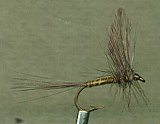 |
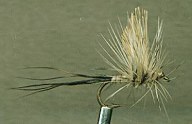 |
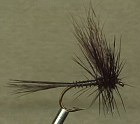 |
END